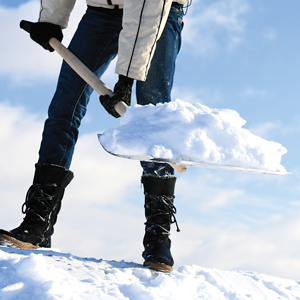After a year of unprecedented warmth, the Farmers’ Almanac reports Virginia is in for a colder than normal winter that will include lots of mixed snow, sleet, and rain. In fact, these experts predict most eastern states – as far south as the Gulf Coast – will experience chillier temps and snowier than typical conditions.
Between this forecast, and the chatter about acorn and holly berry abundance heard in checkout lines across the area, it’s clear Richmonders might want to brace themselves for more snow removal this year than last.
Last year, there were nearly 12,000 emergency room visits nationwide directly related to snow shoveling. That said, there are a few things you can do to make sure that your winter shoveling experiences are safe and pain-free.
Experts say shoveling snow is every bit as stressful on your body as running or mountain biking. A major difference, of course, is that athletes engaging in these activities almost always warm up before they begin exercising. Those of us about to shovel snow should do the same.
Almost every muscle and joint is involved when you shovel snow, and every one of these may be vulnerable to injury. A good full-body warm-up is a smart way to start. A regimen of jumping jacks, arm-swinging, jogging in place, and other general aerobic activities help to bring more blood – and therefore oxygen – to the muscles you will be using while you’re shoveling snow. After about five minutes of warm-up, your heart and breathing rate will have increased a bit and you will actually feel warmer, all signs that more oxygen and energy are getting to the muscles.
Now that you have warmed up, it is time to stretch each muscle group slowly. Try to hold each stretch for 20 to 30 seconds.
After you have dressed in loose layers and protected yourself against the elemaged ments, grab your shovel. Start slowly and increase your effort gradually. Generally, try to concentrate on your posture while shoveling to reduce the likelihood of low-back injury. Keep your back as straight as you can as your body moves from a semi-squat to an upright position, and put the large muscles of your legs to work in the shoveling process.
Remember, it’s always better to push the snow than to lift. When lifting the shovel is necessary, use your shoulder muscles and hold the shovel as close to your upper body as you can. Keep one hand close to the shovel blade to allow leverage to help, and try not to twist your body as you throw each snow-load. Take frequent breaks.
What about your shovel? Studies have shown that investing in an ergonomic snow shovel may help prevent injury. These shovels are lighter than normal shovels, with a handle designed to reduce bending and lifting.
If you think of snow shoveling as an athletic event, and yourself as an elite athlete, you can avoid a lot of aggravation later. If you are getting up there in years, not physically active to begin with, or have a heart condition, what’s your smartest and least aggravating move? You might hire someone else to do your shoveling.




